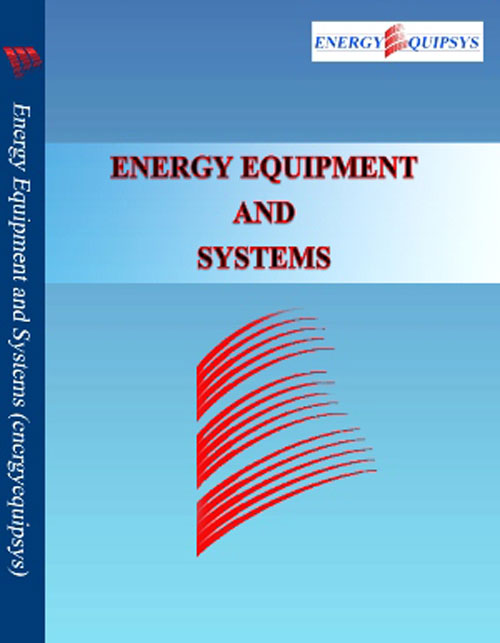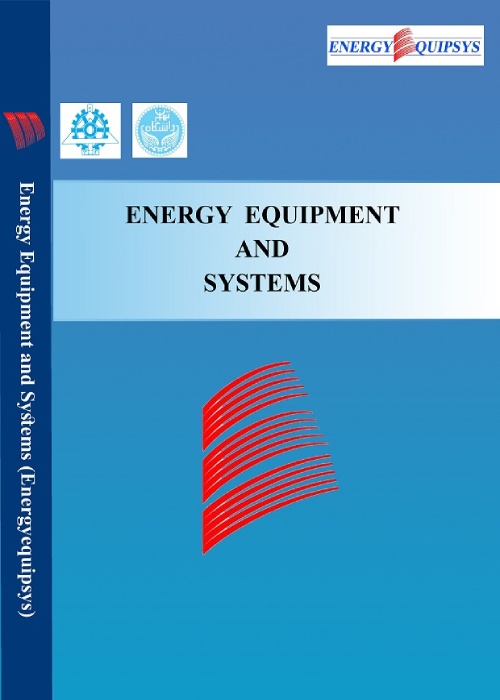فهرست مطالب

Energy Equipment and Systems
Volume:3 Issue: 2, Summer and Autumn 2015
- تاریخ انتشار: 1394/07/30
- تعداد عناوین: 7
-
-
Pages 73-81Energy crisis, global warming and other environmental issues are what motivate researchers to find new strategies to reduce energy consumption in buildings. Recently, using phase change materials (PCM) in the buildings envelopes has drawn significant attention as an energy-saving method, which helps in increasing the buildings thermal capacity. In the present research, the effects of the main thermal parameters including climate conditions, PCM layer thickness and its position, wall thermal resistance, and type of HVAC system [BS1] on the PCM energy-saving potential has been investigated using EnergyPlus software. A climate study has been undertaken in Iran which may be categorized into five climatic regions. Basing on the results, an effective PCM layer is almost 24 cm in thickness, and is embedded in the most interior layer of the wall. This conclusion does not depend on the type of HVAC system. In addition, the results showed that the southern strip of Iran, with a warm humid climate, and a relatively high solar irradiation, has the greatest potential to embed PCMs in the buildings envelopes as a factor for reducing its energy demand. This research and its results are useful in getting a better understanding of the PCMs and their effects on reducing the buildings energy consumption and CO2 emission.Keywords: Phase Change Material, Energy, Saving Method, CO2 Emission Reduction, Climate Study, EnergyPlus
-
Pages 83-95Peltier technology opens new opportunities for special applications. In the current project, this technology was applied to design and fabricate a portable thermoelectric beverage cooler and thermoelectric cup. The simulation and results of the experiment showed that the common beverage cooler is not a suitable design for ignoring the effect of natural convection in cooling. In our thermoelectric cup, the drawbacks of previous design were eliminated. The advantages of the present design over the former design are the heat sink's temperature reduction from 60°C to about 31°C, and the cooling process enhancement, such that the water was cooled down to about 7°C.Keywords: Natural Convection, Peltier Effect, Thermoelectric, Thermoelectric Beverage Cooler, Thermoelectric cup
-
Pages 97-111Laminar mixed convection of Aluminium oxide (Al2O3)water nanofluid flow in an inclined annulus using a single-phase approach was numerically studied. Constant heat flux boundary conditions were applied on the inner and outer walls. All the thermophysical properties of nanofluid, such as, viscosity, heat capacity, thermal conductivity, and thermal expansion coefficient, except density in the body force term were assumed to be constant. Based on Boussinesqs hypothesis, density was assumed to be a linear function of temperature. The nanofluid properties were calculated in terms of constant properties of nanoparticles and the base fluid. Using the finite volume method the continuity, momentum, and energy equations were numerically solved. Numerical simulations were conducted for the nanoparticle concentrations of 0, 2, and 5% and five different inclination angles including -30o, -15o ,0 , 힚, and�. Results showed that a variation in the inclination angle affected the Nusselt number on the inner wall more than the outer one. The Nusselt number in negative angles was higher than in the positive ones, so that at a volume fraction of 5%, the average Nusselt number at the inner wall decreased almost 2% when changing the angle from -30o to�. The local Friction factor in the positive angles was higher than in the negative ones.Keywords: Inclined Annulus, Laminar, Mixed Convection, Nanofluid
-
Pages 113-124One of the most important methods of transporting natural gas in Iran and other parts of the world is the utilization of a network of pipelines. Compression station and turbo compressor units play an important role in gas supply through pipelines. One of the primary concerns in these units is the reduction of fuel consumption. By cooling of exhaust gas from the source station, the pressure drop in the pipeline and fuel consumption can be reduced. In this research, two stations were investigated while ASPEN HYSYS software was used to evaluate the effect of various parameters on pipeline pressure and power compressors. Based on the results of the simulation, the cooling gas at a higher flow was more economical. Moreover, with reducing ambient temperature, there was a decrease in power consumption, which was required for electro fans. Thus, higher rates and lower temperatures of the environment resulted in more profit from cooling operations. Although highest economic efficiency was obtained at the highest flow rate (60 MMSCMD) with cooling at 25℃ and lowest ambient temperature of -8℃, but the conditions for hydrate formation in the pipeline became suitable and these conditions could affect the safety of process. In this study, and taking cognizance of the the limitations of hydrate formation and economic conditions, the cooling operational guidelines for use in Qazvin station are provided.Keywords: ASPEN HYSYS, Compressor Stations, Economice Valuation, Naturalgas, Pipeline
-
Pages 125-136This study presents the manner in which transient modeling concepts, which are fully analyzed in the referred standards, are implemented, for the purpose of evaluating the Transient Ground Potential Rise (TGPR). This is a phenomenon of 10100kV voltages with up to 10μs duration on the grounded enclosure of Gas Insulated Substations (GIS), which may cause concern for personnel safety and problems for protection and control circuits in substations. This article summarizes the results of the investigation for influential factors on TGPR, such as, different contingency conditions and grounding system models. This article focuses on the TGPR study of "Siah-bishe" 400kV gas insulated substation. The study was carried out by modeling all pieces of equipment in the ElectroMagnetic Transients Program (EMTP)-RV, with careful consideration of different modeling guidelines and instructions described in the available standards.Keywords: EMTP, RV, Gas Insulated Substations, Transient Enclosure Voltage, Transient Ground Potential Rise (TGPR), Very Fast Transient (VFT)
-
Pages 137-142Determination of the starter torque-speed diagram is a major task in the design or selection of a proper gas turbine starter. In this paper, the maximum power of the MGT-40 gas turbine starter was calculated based on the dynamics of the rotor, start-up logic, and compressor map. In a recent research, the pressure ratio was assumed as a linear function of the rotor speed and the required starter power was calculated. In this study, the value is determined from the field data. To evaluate the proposed method, the results of obtained power were compared with that of the turbine performance reports. The comparison resulted in a reasonable engineering approximation.Keywords: Compressor Map, Gas Turbine Starter, Start, up Logic, Start, up Power, Torque, Speed Diagram
-
Pages 143-157Wind energy today, has attracted widespread interest from among a variety of sources of renewable energy in the world. Owing to the increasing demand for production of electrical energy for electricity networks by using wind power, it is essential that wind power plants are actively incorporated in the networks performance using an appropriate control system. In general, these wind power plants consist of various types of wind turbines and generators, one of them being a doubly fed induction generator (DFIG). Strict and total control of DFIG is necessary for maintaining a high level of efficiency in utilizing the advantages and benefits of a modern wind plant. To achieve this aim, using the linear controllers is a difficult method because the wind plants involve some uncertainties. Nevertheless, there exists an unstable condition which may reduce the DFIG systems performance. In this research, a predictive control has been proposed for power control in order to overcome these problems. Control is established by optimizing a Cost Function considering the reality of the tracking factors. The prediction has been done on the basis of a DFIG model. Finally, results of the simulations carried out proved the performance of the controller.Keywords: Active, Reactive Power Control, Doubly Fed Induction Generator, Model, Based Predictive Control, Wind Energy


